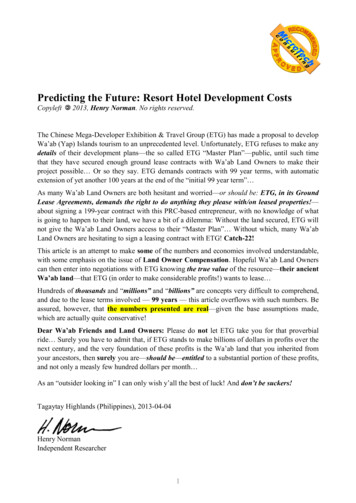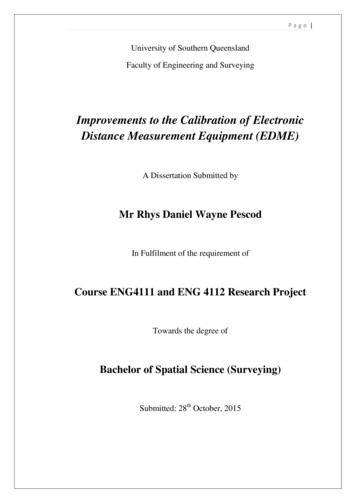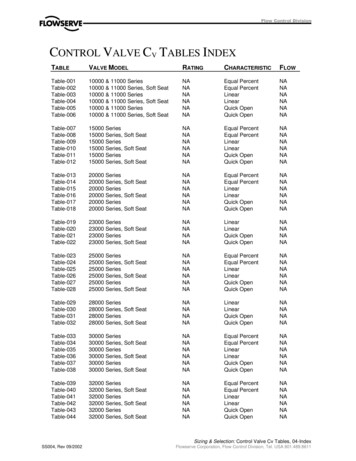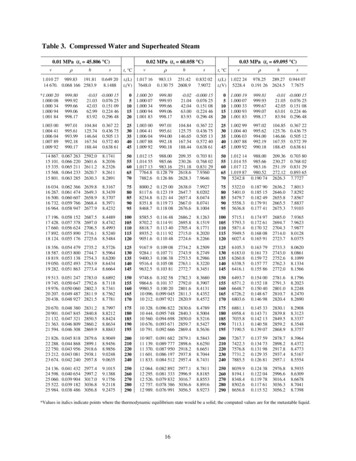
Transcription
Copyright 2022 Limitless Factor Pte LtdAll rights reserved.Published by Karen RichardsonNo part of this publication may be reproduced, stored in a retrieval system, or transmitted in any form or by anymeans, electronic, mechanical, photocopied, recorded, scanned, or otherwise, except as permitted under Canadiancopyright law, without the prior written permission of the author.Notes to the Reader:While the author and publisher of this book have made reasonable efforts to ensure the accuracy and timeliness ofthe information contained herein, the author and publisher assume no liability with respect to losses or damagescaused, or alleged to be caused, by any reliance on any information contained herein and disclaim any and allwarranties, expressed or implied, as to the accuracy or reliability of said information.The publisher and the author make no representations or warranties with respect to the accuracy or completenessof the contents of this work and specifically disclaim all warranties. The advice and strategies contained herein maynot be suitable for every situation. It is the complete responsibility of the reader to ensure they are adhering to alllocal, regional and national laws.This publication is designed to provide accurate and authoritative information in regard to the subject mattercovered. It is sold with the understanding that neither the author nor the publisher is engaged in renderingprofessional services. If legal, accounting, medical, psychological, or any other expert assistance is required, theservices of a competent professional should be sought.The information contained in this book is provided ‘as is’ without warranty of any kind. The entire risk as to theresults and the performance of the information is assumed by the user, and in no event shall the author.com beliable for any consequential, incidental or direct damages suffered in the course of using the information in thisbook.The words contained in this text which are believed to be trademarked, service marked, or to otherwise holdproprietary rights have been designated as such by the use of initial capitalization. Inclusion, exclusion, ordefinition of a word or term is not intended to affect, or to express judgment upon the validity of legal status ofany proprietary right which may be claimed for a specific word or term.The fact that an organization or website is referred to in this work as a citation and/or potential source of furtherinformation does not mean that the author or publisher endorses the information the organization or website mayprovide or the recommendations it may make. Further, readers should be aware that the websites listed in thiswork may have changed or disappeared between when this work was written and when it is read.Important note:None of the statements in this book has been evaluated by the Food and Drug Administration. This book is notintended to diagnose, treat, cure or prevent any disease. You are strongly advised to seek help from a medicaldoctor for all your problemsIndividual results may vary.
Table of ContentsINTRODUCTION . 1CHAPTER 1 . 6MORE AMAZING “HEALTHY BLOOD SUGAR LEVEL” FOODS . 61. Gurmar (Gymnema sylvestre) . 62. Ginseng . 113. Huckleberry . 144. Fenugreek . 165. Chia Seeds . 196. Artichoke (contains silymarin) . 217. Nuts . 25CHAPTER 2 . 28MORE AMAZING “HEALTHY BLOOD SUGAR LEVEL” 5-MINUTE SAUCES,DIPS, SALAD RECIPES, AND JUICES .28Salad Dressings . 29Sauces . 36Dips . 41Juices . 49CHAPTER 3 . 54MORE AMAZING 'HEALTHY BLOOD SUGAR LEVEL' 21-DAY MEAL PLAN. 54Day 1 -7 . 55
Day 8 – 14 . 56Day 15 – 21 . 57Breakfast . 58Lunch . 84Dinner . 113Snacks. 149CHAPTER 4 . 154INCREDIBLE WEIGHT LOSS SECRETS . 154CHAPTER 5 . 182REVERSING THE DAMAGE DONE TO YOUR BODY . 182HOW TO OVERTURN THE DAMAGE OF A SUGAR CRAVING . 188REVERSAL OF ORGAN DAMAGE . 190Liver . 191Brain . 191Lungs . 192Heart . 193CHAPTER 6 . 194OVERCOMING MENTAL ROADBLOCKS . 194Emotions and Weight Loss . 195Being Mentally Ready to Lose Weight. 195Acknowledge How Stress Leads to Overeating . 196Acknowledge How Your Mind Affects Your Health . 198Common Mental Blocks . 199Negative Body Image. 200Individual or Childhood Trauma . 201
Tips to Overcome Barriers . 202Keep a Journal! . 202Make Small Changes . 203Listen to Self-Talk . 204Learn Relaxation Techniques . 204Focus on Good Sleep . 205Seek for Help When Needed . 206Tips on Conquering Your Mental Blocks. 206Think Before You Eat . 207Change Your Mindset . 208Finding a Healthy Attitude . 209Beating Boredom . 210Scared of Being Hungry While Dieting . 211Worrying It is Too Expensive to Lose Weight. 212Thinking Exercise Is Too Hard . 213Feeling Like You Don't Have Enough Time . 213Not Having Overall Diet Motivation . 214Conquering Your Fear of Failure . 215REFERENCES . 217
IntroductionDiabetes is one of the biggest silent killers present in our society today.The considerable prevalence of the disease and the ever-growingnumbers pose a significant health challenge. Not only does it affect thecurrent health status of the patient, but the long-term complicationsof the disease make it a condition that significantly lowers the qualityof life of the patient. However, do not lose hope if you get diagnosedwith diabetes, as multiple lifestyle changes have shown effectivecontainment and even reversal of the disease. The most important ofthese is the dietary control and weight loss approach that significantlybenefits the patient.When you have diabetes, your blood sugar (aka blood glucose) levelsmight be consistently high. Over time, this can harm your body andlead to many other issues. Why are high blood sugar levels bad for yourbody? Glucose is a valuable fuel for all the cells in your body when1
present at ideal levels. But it can act like a slow-acting poison as well.High sugar levels slowly wear down the ability of cells in your pancreasto make insulin. The organ overcompensates, and insulin levels staytoo high. Gradually, the pancreas gets damaged. High blood sugarlevels can cause changes that lead to a hardening of the blood vessels,which medical professionals call atherosclerosis. Keep your bloodsugar levels near to normal to prevent a lot of these problems. TheAmerican Diabetes Association's objectives for blood sugar control inindividuals with diabetes are 70 to 130 mg/dL before meals and lessthan 180 mg/dL after meals. It is always best to let the foods tialantioxidants. More and more people are turning to alternativemedications and supplements. In the subsequent discussion, we delvedeep into the various nutrients and ingredients that have beenscientifically proven to aid in controlling blood sugars level. Thesenutrients have been extensively researched before presenting them toyou so that you as a reader can get the best benefits.2
According to the American Diabetes Association, people with diabetesare most likely to buy supplements than those without the illness.Although beneficial, supplements should not totally replace anyessential diabetes treatment because you can put your health at risk.It is necessary to speak to your doctor before using any supplements.Practically any part of your body can be harmed by excessive sugar.Harmed blood vessels cause kidney failure, requiring dialysis, stroke,cardiovascular disease, vision loss or blindness, and damaged bodyimmune system, with a greater danger of infections.Erectiledysfunction and nerve damage, called neuropathy, triggers tingling,discomfort, or less sensation in your feet, legs, and hands.Among the absolute best ways to handle diabetes is to lose additionalweight. Dial back just a few digits on your bathroom scale, and you willget your blood sugar levels more in check and feel much better overall.Weight loss does not have to be dramatic for you to earn significantresults. A research study observed that when individuals lose around3
7% of their body weight, their insulin level of sensitivity enhances by57%. So, if you weigh 200 pounds, losing just 14 pounds will make adifference.Another objective is to reduce your day-to-day calorie count. Yourequire protein to keep muscle, which assists you in optimizing yourcalorie-burning potential. A minimum of 20% to 30% of your plateought to be comprised of lean protein sources like fish, tofu, andskinless grilled chicken breast. We emphasize various meal plans andrecipes that you can use in your daily life to get the best nutrition forlosing weight and maintaining a healthy lifestyle. Different diet planshave gained traction across the popular media, with the latest evidenceand guidelines pointing towards their effectiveness. We have compileda list of all the dietary programs known to improve metabolic status inpatients with diabetes so that you can find the plan that works the bestfor you.The journey to achieving ideal health is a long one and requires seriouscommitment. We have worked with many individuals through their4
struggles, and it delights us the most when we see the fantastic resultsthey have achieved. We understand how hard it can be to start andeven harder to stay consistent. Therefore, we have dedicated specialsections in our book to assure you how you can reverse the damagedone to your body by decades of inadequate nutrition and unhealthylifestyle choice. It is even harder to overcome the mental roadblock,but as they say, where there is a will, there is a way. So, let us get youstarted on your journey to a healthier lifestyle and better quality of lifewith diabetes without further ado.5
CHAPTER 1More Amazing“Healthy Blood Sugar Level” Foods1. GURMAR (GYMNEMA SYLVESTRE)Gurmar (Gymnema Sylvestre) is a plant in the Apocynaceae family andwell-known in Ayurvedic and herbal medicine for its medicinalpurposes. The plant is found in the tropical regions of India, Africa, andAustralia. The plant has small, yellow flowers that sprout throughout6
the year. G. sylvestre is commonly known as gurmar, which in Hinditranslates to sugar destroyer. 1Gymnema sylvestre leaves contain the active compound, gymnemicacids, which act to suppress the taste of sugar by interacting with tastereceptors on the tongue. This property of suppression of sugar tasteis useful in treating diabetes. Another reason that G. sylvestre isconsidered a sugar destroyer is because it can inhibit sugar absorptionin the body. Thus, the plant has appeared in many research studies andscientific reviews, indicating its effectiveness in treating weight lossand diabetes.Gymnema sylvestre has been shown in studies to lower sugar cravingswhile reducing the rate at which sugar is absorbed into the body,potentially providing a two-fold action to combat weight gain anddiabetes.Preuss, H.G., Jarrell, S.T., et al. (1998). Comparative effects of chromium, vanadium and Gymnema sylvestre onsugar-induced blood pressure elevations in SHR. J Am Coll Nutr 1998; 17:116-123.17
Diabetes is a common disorder caused by the body's inability to utilize(or produce) insulin properly. Lack of insulin production or lack ofinsulin's efficiency (insulin resistance) results in high blood sugar.Hyperglycemia is due to insulin being a hormone responsible formoving the glucose (blood sugar) from the blood into the cell to beused for energy.Many people take insulin or other blood sugar medications that helpthe body regulate glucose levels more efficiently, but a natural plantsupplement, like G. sylvestre, may also help. Gymnema sylvestre mayincrease insulin in the body, possibly by improving cell growth in thepancreas (this is the organ where insulin is produced). Gymnemasylvestre can lower the amount of sugar absorbed from the intestines(where digestion of food and absorption of nutrients occurs).There have been some significant research studies on the healthbenefits of Gymnema sylvestre for maintaining a healthy weight. Aresearch study involved 60 moderately-obese cohorts who consumed8
Gymnema, and the results reported a 5% to 6% decrease in bodyweight and a lower food intake. 2A research study gave participants with type 2 diabetes 500 mg ofGymnema sylvestre a day for three months. 3 The study concluded thatthe participants reported a reduction in several clinical symptomscaused by diabetes. These symptoms included fatigue and thirst,reduced blood glucose levels (including fasting blood sugar as well asrandom blood sugar), a reduction in glycated hemoglobin (a form ofhemoglobin that is bound to glucose), and improvement in lipid (fat)levels.Some common health-promoting properties of G. sylvestre includemotility of the digestive tract, reduction in blood and body fat levels,and reduction in sugar cravings. More research is needed before G.sylvestre can be used as a safe and effective treatment for highcholesterol, fluid retention, or more. Anyone, including those withKumar, S.N., Uliyar, V.M., and Indirani, M. (2010). An Open Label Study on the Supplementation of Gymnema Sylvestre inType 2 Diabetics. Journal of Dietary Supplements. 7 (3): 273–82.3Tiwari, P., Mishra, B.N., and Sangwan, N.S. (2014). Phytochemical and Pharmacological Properties of Gymnema Sylvestre:An Important Medicinal Plant. BioMed Research International. 830285.29
diabetes, should consult with their health care provider before takingG. sylvestre for any condition, including weight loss and appetitesuppression.The tannins and saponins in G. sylvestre are phytochemicals (activecompounds in plants) that are said to have anti-inflammatory abilitiesto help fight inflammation in the body. The active compound in theGymnema plant is a group of acids called gymnemic acid. Gymnemacan be taken in several forms, such as capsules, tincture, powder, ortea. It is essential to always look for a product standardized to containat least 25% gymnemic acid. Avoid taking it on an empty stomach andhave it with food instead, as Gymnema may cause digestive discomfort.Taking Gymnema is generally safe; however, pregnant or lactatingwomen, and people with an allergy to milkweed, should avoid it. Peopleon anti-diabetic medication should take it with caution as a cumulativeblood-sugar-lowering effect may occur. Always consult a qualifiedherbalist or your health care practitioner before taking Gymnema orany herbal supplements in general.10
2. GINSENGGinseng contains several antioxidant compounds called ginsenosides,shown in studies to reduce oxidative stress (to prevent free radicaldamage) and inflammation. Because these are two major contributingfactors in the progression of diabetes, people with the disease maywant to understand better what research has found and consideredwhether ginseng might be a safe and viable part of managing diabetes.A 2014 scientific review of 16 different studies focused on those thatused randomized, controlled groups for 30 days or longer in11
people who had diabetes and those who did not. The resulting metaanalysis revealed that people supplementing with ginseng hadsignificantly improved fasting blood glucose levels than controlgroups. 4 However, the herb did not considerably affect hemoglobinA1C, fasting insulin, or insulin resistance.Yet another study, in 2019, found out that when ginseng was usedalong with oral medications for type 2 diabetes, such as metformin),participants experienced lower systolic blood pressure, fewer bloodlipid markers, and increased nitric oxide generation. 5 These findingssuggest ginseng may improve endothelial function (an indication of thehealth of the inner lining of blood vessels) and protect againstcardiovascular disease.Ginseng is most effective in conjunction with other diabetestreatments, including oral medication and lifestyle measures such aseating a balanced diet rich in fiber and vegetables, getting regularShishtar, E., Sievenpiper, J.L., Djedovic, V., Cozma, A.I., Ha, V., Jayalath, V.H., Jenkins, D.J.A., et al. (2014). The Effect ofGinseng (the Genus Panax) on Glycemic Control: A Systematic Review and Meta-Analysis of Randomized Controlled ClinicalTrials. PloS One 9 (9): e107391.5Chen, W., Balan, P., and Popovich, D.G. (2019). Review of Ginseng Anti-Diabetic Studies. Molecules. 24 (24).https://doi.org/10.3390/molecules24244501.412
exercise, and practicing stress reduction techniques like yoga ormeditation. Although potent, ginseng should not be used in place ofprofessional medical care and should only be taken under the directionof a physician, so talk to your caregiver before incorporating ginsengor any other natural remedy into your diabetes treatment plan.13
3. HUCKLEBERRYHuckleberry is a name used for different plants of the family Ericaceaein North America. These fruits are rich in nutritional elements, and boththe leaves and the berries can be used to treat other diseases, asdescribed in detail later. Huckleberries are rich in phytonutrientsknown as anthocyanins. These antioxidants can help to lower bloodglucose levels. 6 Huckleberry also contains chromium, a mineralextremely useful in diabetic patients to lower blood glucose levels. 7Barney, D., Exon, J., Taruscio, T., et al. (2004). Content and Profile of Flavanoid and Phenolic Acid Compounds in Conjunctionwith the Antioxidant Capacity for a Variety of Northwest Vaccinium Berries. Journal of Agricultural and Food Chemistry, vol.52, no. 10, pp. 3169-3176.7Harrington, H.D. (1972) Western edible wild plants. The University of New Mexico Press. 156 pp.614
They are a rich source of iron, which helps produce more red bloodcells.The leaves of huckleberry contain flavonoids, another antioxidantgroup, which improves blood circulation in diabetic patients. These teaplants help alleviate hyperglycemic and glycosuria in diabetic patients,especially those with type 2 diabetes mellitus. As you may see,huckleberry health benefits can be obtained by various mechanisms.Using huckleberry in supplements, tinctures, or natural forms will helpreduce the blood sugar levels while also assisting anemic patients inproducing red blood cells because they are an excellent iron source.15
4. FENUGREEKFenugreek is a plant that grows in parts of Europe and western Asia.The leaves are edible, but the small brown seeds are famous for theiruse in medicine. You can buy fenugreek, a spice (in whole or powderedform), a supplement (in concentrated pill and liquid form), tea, and skincream. Fenugreek seeds have been found helpful for people withdiabetes.Many of these studies focus on the herbal seed's ability to lower bloodsugar in people with diabetes. One small 2009 found that a daily dose16
of 10 grams of fenugreek seeds soaked in hot water may help controland manage type 2 diabetes. 8 Another scientific study observed thateating baked goods, such as bread, made with fenugreek flour mayreduce insulin resistance in people with type 2 diabetes. Fenugreekseeds have a bitter, nutty taste and are most often used in spiceblends. Sub-continental and Indian recipes use them in curries,pickles, and other sauces. One can also drink fenugreek tea or sprinklepowdered fenugreek over yogurt. If you are not sure how to usefenugreek, ask your dietitian to help you add it to your current diabetesmeal plan. There have not been any serious or life-threatening sideeffects or complications connected with fenugreek.Apart from its beneficial effects in diabetes, fenugreek is known to haveother potential benefits too. A 2007 study even found that fenugreekcan protect your liver from toxins' effects. 9 Furthermore, a 2009research study suggests that fenugreek can stop cancer cells' growthBawadi, H.A., Maghaydah, S.N., Tayyem, R.F., and Tayyem, R.F. (2009). The Postprandial Hypoglycemic Activity of FenugreekSeed and Seeds’ Extract in Type 2 Diabetics: A Pilot Study. Pharmacognosy Magazine 5 (18): 134.9Xue, W.L., Li, X.S, Zhang, J., Liu, Y.H., Wang, Z.L., and Zhang, R.J. (2007). Effect of Trigonella Foenum-Graecum (fenugreek)Extract on Blood Glucose, Blood Lipid and Hemorheological Properties in Streptozotocin-Induced Diabetic Rats. Asia PacificJournal of Clinical Nutrition. 16 Suppl 1: 422–26.817
and potentially act as an anticancer herb. Fenugreek can also helpalleviate the symptoms of dysmenorrhea (painful menstrual cycle).18
5. CHIA SEEDSChia is an herb belonging to the Lamiaceae plant family, related to mintand sage. It grows in Mexico and Central America. Many studies on thechia seeds found that a high-chia diet led to lower LDL, or badcholesterol, and higher HDL, the good cholesterol. Eating a lot of chiaalso lowered triglycerides (blood fat levels). In a study with a cohort of20 patients with diabetes, one variety of seeds called Salba helpedparticipants control blood glucose, reduce blood pressure, and lowerC-reactive protein, a significant heart disease risk marker. 10Ullah, R., Nadeem, M., Khalique, A., Imran, M., Mehmood, S., Javid, A., and Hussain, J. (2016). Nutritional and TherapeuticPerspectives of Chia (Salvia Hispanica L.): A Review. Journal of Food Science and Technology. 53 (4): 1750–58.1019
The omega-3 oils and antioxidants in chia seeds are healthy, but thefiber content may significantly benefit the human body. Chia seedsseem to slow glucose passage and absorption into the blood. They areknown for quicker satiety, and therefore reduce appetite. Chia seedscan be added to water, juice, or milk to make a thick liquid, swallowed,or used in baking as an egg substitute. You can also add them to soups,salad dressings, or smoothies as a nutritious thickener.The seeds have a long shelf life and can last over two years withoutgoing bad, longer than processed foods. Chia seeds are widelyavailable in stores or any corner grocery store.20
6. ARTICHOKE (CONTAINS SILYMARIN)The artichokes’ tender insides are commonly used in almost everythingfrom pizza to salads. Artichoke offers a tremendous amount of healthbenefits, and it is relatively low in calories. One medium-sized artichokecontains 60 calories. As a fiber-packed green vegetable, artichoke isrecommended as part of a healthy diabetes diet. One medium-sizeartichoke contains 7 grams, which makes them just 7 grams net carbcount. Artichokes are one of the absolute best ways to get your dailyfiber, and it is exceptionally high in soluble fiber. Generally, people donot get enough fiber from their regular diets. Therefore, it is essential21
to consume vegetables like artichokes to reduce the risk of digestiveissues and gut-related problems while regulating blood glucose andcholesterol control. 11Artichoke is one vegetable known as a "prebiotic" fiber. 12 It is mainlydue to its property to feed the beneficial gut bacteria, which has theoffset of producing many additional health benefits. Artichokes' highcontent of vitamin K may protect against Alzheimer's and other braindiseases. It also helps with blood clotting and supports bone health.The potassium in artichoke can help regulate blood pressure,counteracting the blood pressure-raising effect of dietary sodium.Jerusalem artichoke may reduce lipid disturbance and insulinresistance, helping prevent type 2 diabetes and nonalcoholic fatty liverdisease. 13Yang, H.J., Kwon, D.Y., Kim, M.J., Kang, S., Kim, D.S., and Park, S. (2012). Jerusalem artichoke and chungkookjang additivelyimprove insulin secretion and sensitivity in diabetic rats. Nutrition & Metabolism. 9:112.12Elaheh, M., Ali, M. S., Elnaz, M., and Ladan, N. (2016). Prebiotic effect of Jerusalem artichoke (Helianthus tuberosus)fructans on the growth performance of Bifidobacterium bifidum and Escherichia coli. Asian Pac J Trop Dis. 6(5): 385-38911Rangboo, V., Noroozi, M., Zavoshy, R., Rezadoost, S.A, and Mohammadpoorasl, A. (2016). The Effect of Artichoke LeafExtract on Alanine Aminotransferase and Aspartate Aminotransferase in the Patients with Nonalcoholic Steatohepatitis. Int JHepatol. 2016: 4030476.1322
Artichoke leaf extract has been found in research studies to decreaseoxidative stress due to its antioxidant content. Artichoke leaves mayprotect against organ damage and cancer and even slow the body'snatural aging processes. Perhaps the most exciting fact for people withdiabetes is that consuming artichoke may help regulate blood glucose.Artichoke is prebiotic and essential to controlling gut health.If you are taking blood-thinner medications such as warfarin, it is vitalto be aware of artichoke's high vitamin K content. Choose the heaviest,firmest artichokes possible, and look for a bright green color andcompact center leaves. The peak season for fresh artichokes is Marchthrough May, but canned and jarred varieties are available year-round.You can test for freshness by pressing the leaves against one another,and if they make a squeaking sound, the artichoke is fresh.Interestingly, many people feel that slightly frozen artichokes have thebest taste. Fresh artichokes can be stored unwashed in a plastic bagin the fridge for up to one week. Cooked artichokes need to stay23
refrigerated for up to four days — Cook the artichokes before they arefrozen.24
7. NUTSNuts provide several benefits for people with diabetes. Studies suggestthat nuts may even decrease the risk of type 2 diabetes. Nutconsumption has also b
translates to sugar destroyer. 1. Gymnema sylvestre leaves contain the active compound, gymnemic acids, which act to suppress the taste of sugar by interacting with taste receptors on the tongue. This property of suppression of sugar taste is useful in treating











